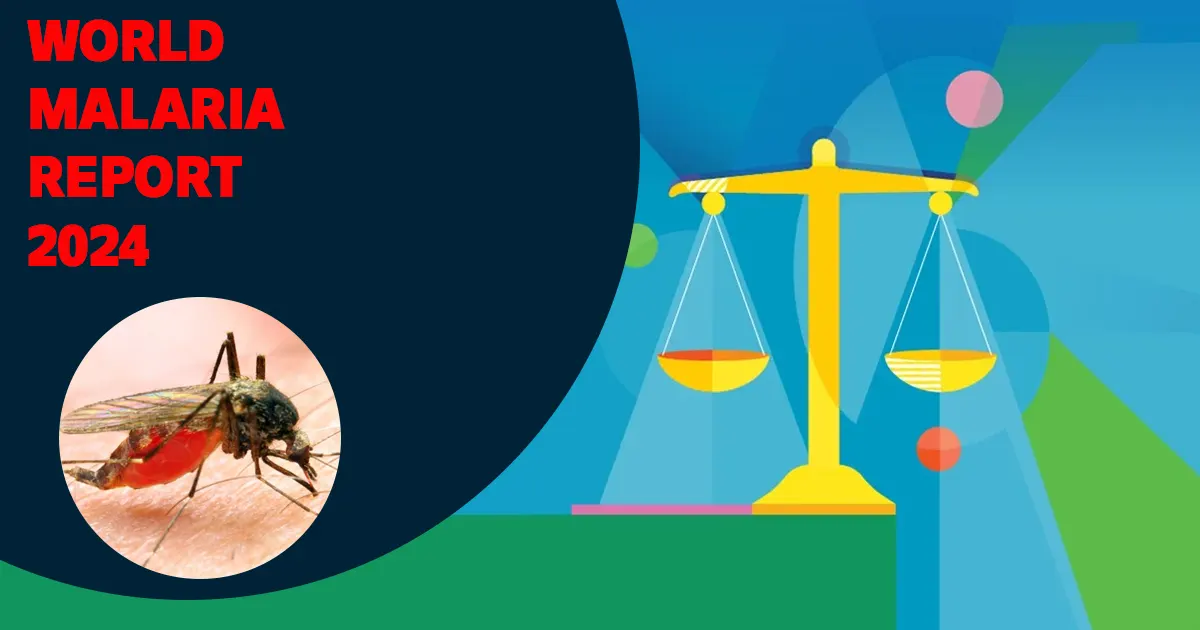GS-2-Disease

Why in News?
The 2024 World Malaria Report has been published by the World Health Organization (WHO), highlighting India’s “significant progress” in reducing both malaria incidence and mortality.
What is Malaria?
About
- Malaria is an acute febrile illness caused by Plasmodium parasites, which are transmitted to humans through bites of infected female Anopheles mosquitoes.
- This life-threatening disease is predominantly found in tropical and subtropical regions.
- Importantly, malaria is both preventable and curable with the right interventions.
Transmission of Malaria
- Malaria is not a contagious disease and cannot spread directly from one person to another.
- The infection is exclusively transmitted via bites from infected female Anopheles mosquitoes.
Key Parasites
- Five species of Plasmodium parasites can infect humans.
- Among these, two species pose the greatest risk:
- Plasmodium falciparum
- Plasmodium vivax
Key Highlights of the WHO’s World Malaria Report 2024
Global Burden (2023)
- 263 million malaria cases and 597,000 deaths were reported worldwide.
- The WHO African Region accounted for 95% of deaths, with young children and pregnant women being disproportionately affected.
Global Progress Since 2000
- 2.2 billion malaria cases and 12.7 million deaths were averted globally.
- Malaria case incidence has dropped significantly, with consistent improvements across many regions.
Certification of Malaria-Free Countries
- As of November 2024, the WHO has certified 44 countries and one territory, including Egypt (most recent), as malaria-free.
- Certification requires three consecutive years of zero indigenous malaria cases.
- 25 malaria-endemic countries now report fewer than 10 cases annually, compared to only 4 in 2000.
Country-Specific Trends in Malaria Cases
- Reduction in Cases (2022-2023):
- Nepal: -58.3%
- India: -9.6%
- Bangladesh: -9.2%
- Indonesia: -5.7%
- Increases in Cases:
- North Korea: +47.9%
- Thailand: +46.4%
- Myanmar: +45.1%
- Zero indigenous malaria cases reported in Timor-Leste and Bhutan in 2023.
South-East Asia’s Contribution to Malaria Reduction
- The WHO South-East Asia Region accounted for 1.5% of global malaria cases in 2023, with India contributing nearly half and Indonesia about one-third.
- Malaria cases in the region dropped by 82.4%, from 22.8 million in 2000 to 4 million in 2023.
- Malaria deaths in the region fell by 82.9%, from 35,000 in 2000 to 6,000 in 2023, with India and Indonesia accounting for 88% of these deaths.
Challenges
- Challenges in Africa: Despite global progress, Africa remains the most affected region by malaria.
- Funding and Systemic Challenges:
- Funding in 2023 reached $4 billion, well below the $8.3 billion target set by the Global Technical Strategy.
- Gaps in insecticide-treated nets, medicines, and other critical tools due to insufficient funding.
- Challenges include fragile health systems, weak surveillance, and threats like drug and insecticide resistance.
- Exacerbating factors include conflicts, natural disasters, climate change, and population displacement.
Recommendations for Equity and Innovation
- Focus on robust data systems to monitor health inequities, with data disaggregated by sex, age, and social factors.
- Emphasis on equity, gender equality, and human rights as key principles in anti-malaria innovations.
- Engagement of affected communities in the development and evaluation of new tools and approaches.
Call to Action
- To maintain progress and tackle persistent challenges, WHO urges increased investments, innovative approaches, and targeted action in high-burden regions, particularly in Africa.
India-Specific Observations in the WHO’s World Malaria Report 2024
India Exits the High-Burden-High-Impact (HBHI) Group: Milestone in Malaria Control
- India has successfully exited the HBHI group of malaria-endemic countries, marking a significant milestone in malaria control.
- The country has made impressive strides in reducing its malaria burden:
- Malaria cases decreased by 69%, from 6.4 million in 2017 to 2 million in 2023.
- Malaria deaths fell from 11,100 to 3,500 during the same period.
Key Strategies Behind India’s Success
- Artemisinin-Based Combination Therapy (ACT):
- ACT is the cornerstone of India’s treatment strategy, where Artemisinin is used to kill the majority of malaria parasites, while a partner drug clears the remaining parasites, ensuring better cure rates and reduced resistance.
- Long-Lasting Insecticidal Nets (LLIN):
- The widespread use of LLINs has helped reduce malaria transmission by blocking and killing mosquitoes, which reduces mosquito populations and their lifespan, especially in high-risk areas.
- Targeted Interventions:
- Focused efforts have been made in forest and tribal areas, especially in states like Jharkhand, Odisha, Chhattisgarh, and the North-East. These areas were prioritized for:
- Improved access to diagnostics, treatments, and medications.
- Distribution of new-generation insecticide-treated nets, offering enhanced protection in these high-risk regions.
- Focused efforts have been made in forest and tribal areas, especially in states like Jharkhand, Odisha, Chhattisgarh, and the North-East. These areas were prioritized for:
- Effective Monitoring and Case Management:
- Consistent evaluations of the implementation of interventions have helped improve case management and ensure effective coverage of malaria control programs across the country.




